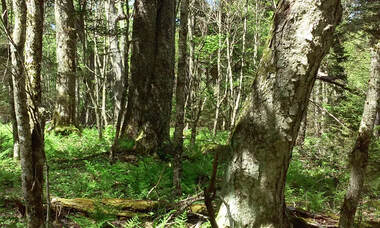 Yellow Birch Old Growth in Little Wilson Creek Wilderness, JNF
Yellow Birch Old Growth in Little Wilson Creek Wilderness, JNF The Forest Service has published an advance notice of proposed rulemaking, inviting public comment on the following topic:
Given that climate change and related stressors are resulting in increasing impacts with rapid and variable rates of change on national forests and grasslands, how should the Forest Service adapt current policies to protect, conserve, and manage the national forests and grasslands for climate resilience, so that the Agency can provide for ecological integrity and support social and economic sustainability over time?
Please consider letting the Forest Service know that protecting old growth forests will promote climate resilience. They are accepting comments until July 20, 2023.
What are the special values [of old growth]? Most of us have long valued stands of mature, tall, large diameter trees on our national forest, for their aesthetic and their recreational values, plus their superior characteristics in providing food for various wildlife species, in ability to purify the air, in preventing erosion and at the same time enabling the soil to retain, then slowly release precipitation, in harboring increased microscopic life in the undisturbed soil (the basic element in the food chain), and other factors that biologists with their scientific understanding know.
-Ernie Dickerman, February 1998
You may send comments by any of the following methods by July 20.
Preferred: Federal eRulemaking Portal www.regulations.gov .
Mail: Director, Policy Office, 201 14th Street SW, Mailstop 1108, Washington, DC 20250–1124.
Given that climate change and related stressors are resulting in increasing impacts with rapid and variable rates of change on national forests and grasslands, how should the Forest Service adapt current policies to protect, conserve, and manage the national forests and grasslands for climate resilience, so that the Agency can provide for ecological integrity and support social and economic sustainability over time?
Please consider letting the Forest Service know that protecting old growth forests will promote climate resilience. They are accepting comments until July 20, 2023.
What are the special values [of old growth]? Most of us have long valued stands of mature, tall, large diameter trees on our national forest, for their aesthetic and their recreational values, plus their superior characteristics in providing food for various wildlife species, in ability to purify the air, in preventing erosion and at the same time enabling the soil to retain, then slowly release precipitation, in harboring increased microscopic life in the undisturbed soil (the basic element in the food chain), and other factors that biologists with their scientific understanding know.
-Ernie Dickerman, February 1998
You may send comments by any of the following methods by July 20.
Preferred: Federal eRulemaking Portal www.regulations.gov .
Mail: Director, Policy Office, 201 14th Street SW, Mailstop 1108, Washington, DC 20250–1124.

 RSS Feed
RSS Feed